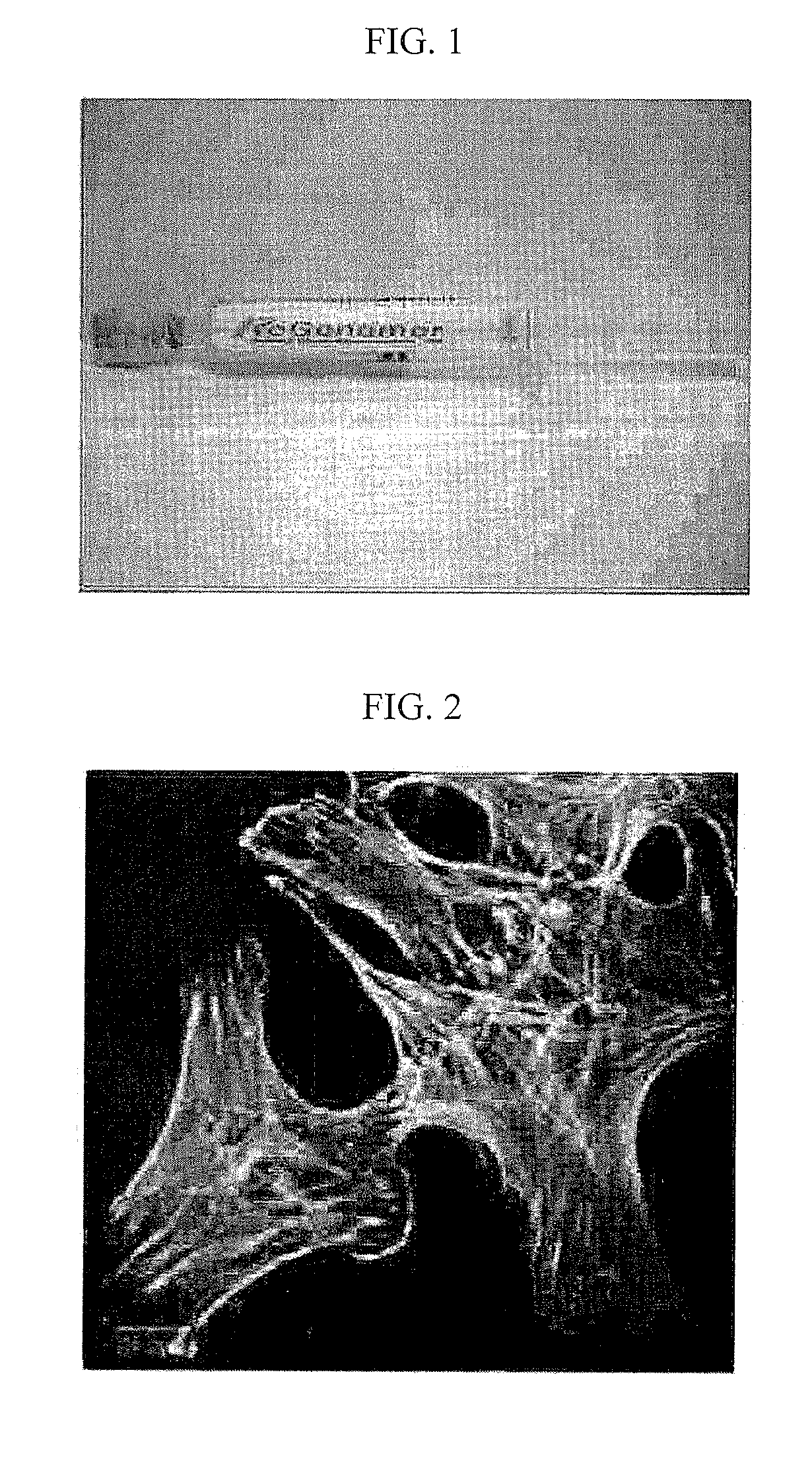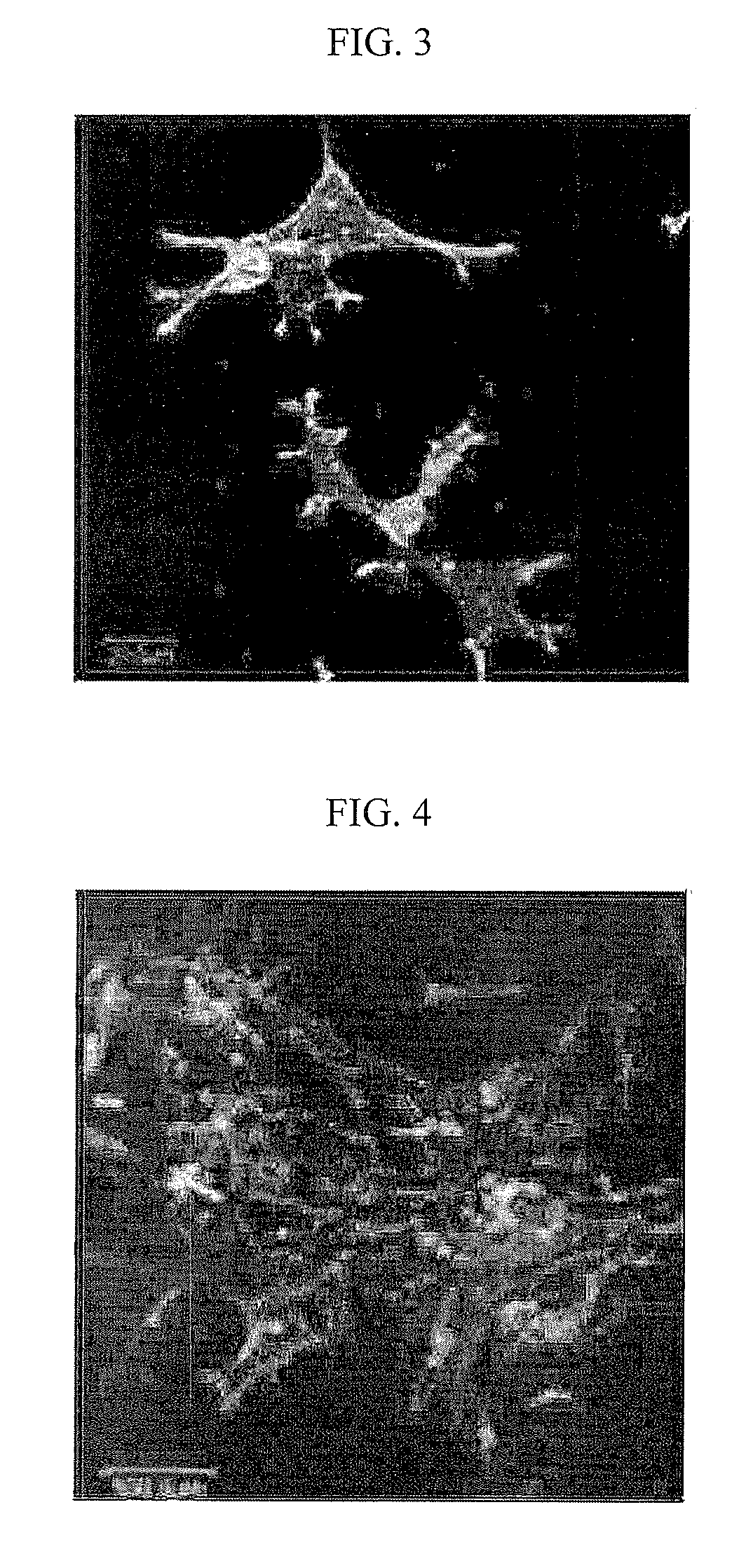Injectable bone regeneration gel containing bone formation enhancing peptide
a bone regeneration gel and injection technology, applied in the direction of peptide/protein ingredients, drugs, prosthesis, etc., can solve the problems of not yet being developed, osteogenesis can be induced, and the graft material can completely fill the bone defect,
- Summary
- Abstract
- Description
- Claims
- Application Information
AI Technical Summary
Benefits of technology
Problems solved by technology
Method used
Image
Examples
example 1
Incorporation of Bone Formation Enhancing Peptide into Sodium Alginate
[0032]A bone formation enhancing peptide used in this Example was a peptide of SEQ ID NO: 6. 7 g of sodium alginate (Sigma) was dissolved in 100 mL of 5% (w / v) tripolyphosphate, and then, autoclaved. 50 mg of calcium sulfate was added to 10 mL of the above solution and well mixed. 1 g of bone formation enhancing peptide was added and well mixed, and then injected into a syringe (FIG. 1).
example 2
Covalent Bond of Bone Formation Enhancing Peptide to Sodium Alginate
[0033]Sodium alginate was dissolved in a 0.1M MES buffer (0.1M MES, morpholinoethane sulfonic acid, 0.3M NaCl, pH 6.5) at a concentration of 1% (w / v, 100 mg / 100 mL). 1-ethyl-3-(3-dimethylaminopropyl) carbodiimide (EDC) (50 mg EDC / g alginate) and N-hydroxysulfosuccinimide(sulfo-NHS)(28 mg sulfo-NHS / g alginate) were added and allowed to react with stirring for 30 minutes, thus activating carboxylic acid group of alginate. Peptides were added thereto at a certain ratio and allowed to react with stirring at room temperature for 24 hours. Buffer salts, reaction byproducts and unreacted peptides were removed from a reaction solution in deionized water for 24 hours with dialysis tubing (MWCO 3500), and a solvent was removed by lyophilizing, thus obtaining peptide-sodium alginate.
[0034]7 g of the obtained peptide-sodium alginate was dissolved in 100 mL of 5% (w / v) tripolyphosphate, and 50 mg of calcium sulfate was added to ...
experimental example 1
Cell Adhesion to Injectable Bone Regeneration Materials According to the Present Invention
[0035]Injectable bone regeneration materials prepared in Example 1 were put into 4 wells to inoculate cells on them, then cells were cultured for 24 hours. Human osteosarcoma cells were obtained from Korean Cell Line Bank (KCLB No. 21543) to use. Bone regeneration materials, into which the cells were inoculated to culture, were fixed with 2% glutaraldehyde solution. The fixed bone regeneration materials were treated with 1% triton X-100, and then cell nuclei were stained with DAPI (Molecular Probe, blue) and actins were stained with Alexa Flour 488 (Molecular Probe, green). Focal adhesion was primarily stained with Rabbit primary vincluin antibody (Sigma) and then secondarily stained with Alexa Fluor 568 mouse anti-rabbit IgG (Molecular Probe, red). After staining, the cells attached to the bone regeneration materials were washed to observe with a confocal laser scanning fluorescence microscope...
PUM
| Property | Measurement | Unit |
|---|---|---|
| concentration | aaaaa | aaaaa |
| concentration | aaaaa | aaaaa |
| diameter | aaaaa | aaaaa |
Abstract
Description
Claims
Application Information
 Login to View More
Login to View More - R&D
- Intellectual Property
- Life Sciences
- Materials
- Tech Scout
- Unparalleled Data Quality
- Higher Quality Content
- 60% Fewer Hallucinations
Browse by: Latest US Patents, China's latest patents, Technical Efficacy Thesaurus, Application Domain, Technology Topic, Popular Technical Reports.
© 2025 PatSnap. All rights reserved.Legal|Privacy policy|Modern Slavery Act Transparency Statement|Sitemap|About US| Contact US: help@patsnap.com



